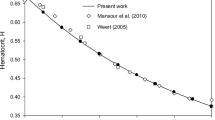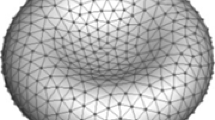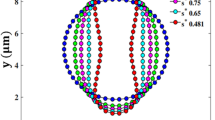Abstract
Numerical simulations of the motion of red blood cells (RBCs) freely suspended in shear flow have been successfully performed to investigate the nature of pairwise interception of RBCs using a fluid-particle interaction method based on the arbitrary Lagrangian-Eulerian (ALE) method and a dynamic mesh method. The applicability of the interaction method that we used was validated by comparing the simulation results with an analytical solution for an elliptical particle in shear flow. We found that positive and negative transverse shifts of the RBCs take place during the interceptions, yielding a non-zero RBC self-diffusivity, and that a phase shift occurs during the rotating behavior and lasts even after the separation. The behaviors of the approaching RBCs are adjusted by interactions with the surrounding flow fields during interception. The pressure between a pair of RBCs causes either an attractive or repulsive force. The nature of the pairwise interception is influenced not only by the flow fields but also by kinematic characteristics (i.e., instantaneous translational and rotational behavior) of the two RBCs.
Similar content being viewed by others
References
H. H. Hu, Direct simulation of flows of solid-liquid mixtures, Int. J. Multiphase Flow, 22 (1996) 335–352.
J. J. Feng, P. Huang and D. D. Joseph, Dynamic simulation of sedimentation of solid particles in an Oldroyd-B fluid, J. Non-Newtonian Fluid Mech., 26 (1996) 63–88.
H. H. Hu, M. Y. Zhu and N. Patankar, Direct numerical simulations of fluid solid systems using the arbitrary Lagrangian Eulerian technique, J. Comput. Phys., 169 (2001) 427–462.
T. Gao and H. H. Hu, Deformation of elastic particles in viscous shear flow, J. Comput. Phys., 228 (2009) 2132–2151.
R. Lima, T. Ishikawa, Y. Imai, M. Takeda, S. Wada and T. Yamaguchi, Radial dispersion of red blood cells in blood flowing through glass capillaries: The role of hematocrit and geometry, J. Biomech., 41 (2008) 2188–2196.
G. B. Jeffery, The Motion of ellipsoidal particles immersed in a viscous fluid. Proceedings of the Royal Society of London. Series A, Containing papers of a mathematical and physical character, 102 (1922) 161–179.
S. R. Keller and R. Skalak, Motion of a tank-treading ellipsoidal particle in a shear flow, J. Fluid Mech., 120 (1982) 27–47.
F. Rioual, T. Biben and C. Misbah, Analytical analysis of a vesicle tumbling under a shear flow, Phys. Rev. E: Stat. Phys. Plasmas Fluids, 69 (2004) 061914.
M. Abkarian, M. Faivre and A. Viallat, Swinging of red blood cells under shear flow, Phys. Rev. Lett., 98 (2007) 188302.
J. M. Skotheim and T. W. Secomb, Red blood cells and other non-spherical capsules in shear flow: Oscillatory dynamics and the tank-treading-to-tumbling transition, Phys. Rev. Lett., 98 (2007) 078301.
R. R. Huilgol and N. Phan-Thien, Fluid Mechanics of Viscoelasticity, Elsevier, Amsterdam, (1997).
D. I. Dratler and W. R. Schowalter, Dynamic simulation of suspensions of non-Brownian hard spheres, J. Fluid Mech., 325 (1996) 53–77.
D. I. Dratler, W. R. Schowalter and R. L. Hoffman, Dynamic simulation of shear thickening in concentrated colloidal suspensions, J. Fluid Mech., 353 (1997) 1–30.
J. J. Stickel and R. L. Powell, Fluid mechanics and rheology of dense suspensions, Ann. Rev. Fluid Mech., 37 (2005) 129–149.
N. Phan-Thien, X. J. Fan, R. I. Tanner and R. Zheng, Folgar-Tucker constant for a fiber suspension in a Newtonian fluid, J. Non-Newtonian Fluid Mech., 103 (2002) 251–260.
S. Chandrasekhar, Liquid crystals, Cambridge University Press, Cambridge, (1992).
M. Doi and S. F. Edwards, The theory of polymer dynamics, Oxford University Press, New York, (1986).
B. J. Yoon and S. Kim, A boundary collocation method for the motion of two spheroids in Stokes flow; hydrodynamic and colloidal interaction, Int. J. Multiphase Flow, 16 (1990) 639–649.
C. J. S. Petrie, The rheology of fibre suspensions, J. Non-Newtonian Fluid Mech., 87 (1999) 369–402.
C. Pozrikidis, Orientation statistics and effective viscosity of suspensions of elongated particles in simple shear flow, Eur. J. Mech. B. Fluids, 24 (2005) 125–136.
C. Pozrikidis, Interception of two spheroidal particles in shear flow, J. Non-Newtonian Fluid Mech., 136 (2006) 50–63.
E. A. Evans and R. Skalak, editors. Mechanics and thermodynamics of biomembranes, CRC Press, Boca Raton, FL, (1980).
J. Li, M. Dao, C. T. Lim and S. Suresh, Spectrin-level Modeling of the cytoskeleton and optical tweezers stretching of the erythrocyte, Biophys. J., 88 (2005) 3707–3719.
R. Skalak and S. Chien, Handbook of Bioengineering, McGraw-Hill, New York, (1987).
FLUENT 6.3 documentation, ANSYS.
S. R. Keller, A model for erythrocyte tank-treading motion in a shear flow. In 1979 Advances in Bioengineering (ed. M. K. Wells), A.S.M.E., (1979) 125–127.
C. Migliorini, Y. Qian, H. Chen, E. B. Brown, R. K. Jain and L. L. Munn, Red blood cells augment leukocyte rolling in a virtual blood vessel, Biophys. J., 83 (2002) 1834–1841.
C. Sun, C. Migliorini and L. L. Munn, Red blood cells initiate leukocyte rolling in postcapillary expansions: A lattice Boltzmann analysis, Biophys. J., 85 (2003) 208–222.
C. Sun, L. L. Munn, Lattice-Boltzmann simulation of blood flow in digitized vessel networks, Computers and Mathematics with Applications, 55 (2008) 1594–1600.
B. Neu and H. J. Meiselman, Depletion-mediated red blood cell aggregation in polymer solutions, Biophys. J., 83 (2002) 2482–2490.
Author information
Authors and Affiliations
Corresponding author
Additional information
This paper was recommended for publication in revised form by Associate Editor Haecheon Choi
Choeng Ryul Choi is researching at the Department of Mechanical Engineering, College of Engineering, Kyung Hee University. He is interested in computational fluid dynamics, fluid-structure interaction, and physics of complex system
Chang Nyung Kim is a full professor of the Department of Mechanical Engineering, College of Engineering, Kyung Hee University in the Republic of Korea. His research focuses on computational fluid dynamics, micro-fluidic flow, heat transfer, biomechanics, and environmental fluid mechanics.
Rights and permissions
About this article
Cite this article
Choi, C.R., Kim, C.N. Fluid-particle interaction simulations of the interception of red blood cells in shear flow. J Mech Sci Technol 24, 1451–1463 (2010). https://doi.org/10.1007/s12206-010-0421-5
Received:
Revised:
Accepted:
Published:
Issue Date:
DOI: https://doi.org/10.1007/s12206-010-0421-5




